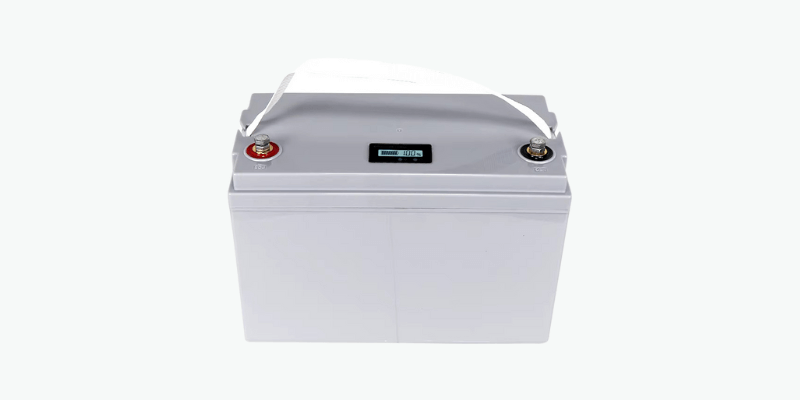For vellykket sejlsport og marineeventyr er det vigtigt at have en pålidelig strømkilde. Marinebatterier er designet til at give pålidelig strøm til både og kan modstå barske forhold som saltvandseksponering, vibrationer og ekstreme temperaturer. Dette blogindlæg vil dække det grundlæggende i marinebatterier, og hvordan du vælger det rigtige til dine behov.
Hvad er marinebatterier?
Marinebatterier er specielle batterier designet til at drive både og andre marinekøretøjer. De tåler vibrationer, ekstreme temperaturer og fugt.
Der er tre typer marinebatterier: start, dyb cyklus og dobbeltfunktion. Startbatterier sikrer stærk motortænding, mens deep cycle-batterier leverer konstant strøm til langvarig brug af elektriske systemer. Dual-purpose batterier tjener begge funktioner.
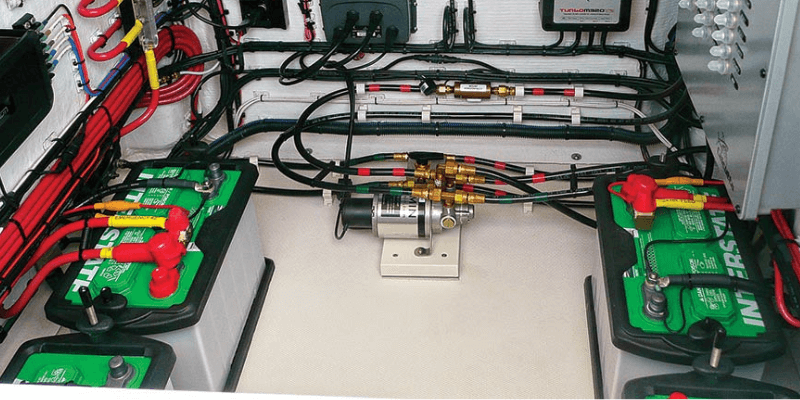
Starter batterier
Marine startbatterier, eller marine startbatterier, er bly-syre batterier designet til at starte bådmotorer. De giver forstærkere med høj start (CA) og forstærker med kold start (CCA) for hurtig tænding.
CA måler strømforsyningen ved 32°F (0°C) i 30 sekunder, velegnet til mildere klimaer. CCA angiver den maksimale strøm, et batteri kan levere ved 0°F (-18°C), afgørende for start i koldt vejr, når motorolien er tykkere. For mere information om CCA, se vores blogindlæg "Hvad betyder CCA på et batteri."
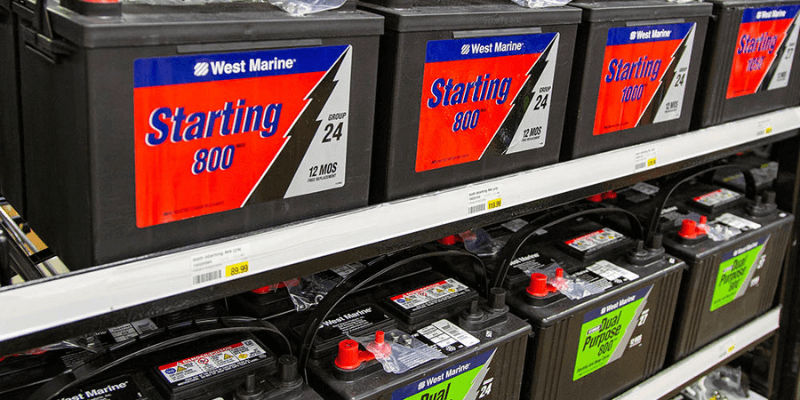
Deep Cycle batterier
Deep-cycle marine batterier giver konstant strøm over længere perioder, hvilket gør dem ideelle til kontinuerlige applikationer.
I modsætning til startbatterier, som leverer korte udbrud af høj strøm til motorstart, har deep-cycle batterier tykkere blyplader til at modstå gentagne dybe afladninger og genopladninger. De driver forskellige bådsystemer og -apparater, herunder lys, motorer, fiskeekkolod, radioer og køleskabe.
Disse batterier er nødvendige for stor kraft under sejlsportsaktiviteter, så sejlere kan nyde tiden på vandet uden at bekymre sig om afbrydelser.

Dual Purpose batterier
Dual-purpose batterier kombinerer start- og dybcyklusfunktioner, der giver kraften til at starte en motor, mens de understøtter indbygget elektronik. Mange moderne deep-cycle marine batterier tilbyder denne egenskab.
Til mindre både med mindre krævende motorer er et kvalitetsbatteri med to formål tilstrækkeligt. Men større både med kraftige motorer eller flere tilbehør har normalt brug for et dedikeret startbatteri og separate deep-cycle batterier til at drive tilbehør.
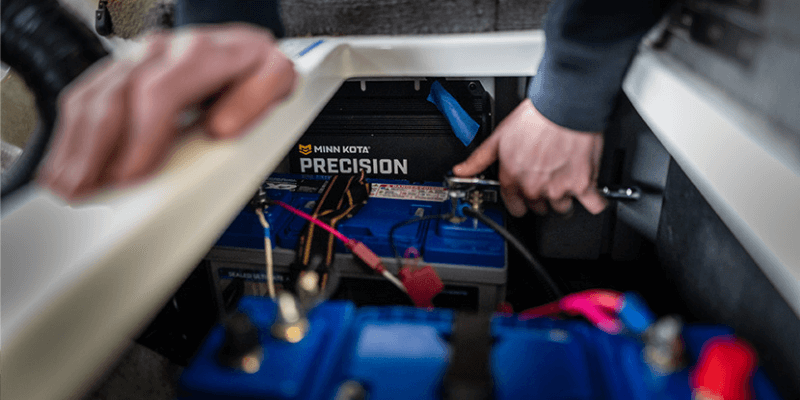
Hvordan er marinebatterier forskellige?
Marinebatterier er designet til at klare udfordringerne i havmiljøet, herunder bevægelse, vibrationer og fugt. De har forbedret konstruktion og komponenter, der beskytter batteripladerne mod vibrationsskader under hårdt vand eller høje hastigheder.
For at imødegå sikkerhedsrisici inkluderer mange marinebatterier gnistfangere for at forhindre eksplosioner fra utilsigtede gnister under opladning.
Derudover modstår de korrosion fra saltvand ved at bruge holdbare materialer som blylegeringer.
Endelig tilbyder marinebatterier forskellige terminaltyper og -størrelser for kompatibilitet med forskellige bådopsætninger og elektriske systemer, herunder specialiserede designs for at forhindre kortslutninger eller aktivere funktioner til hurtig forbindelse.
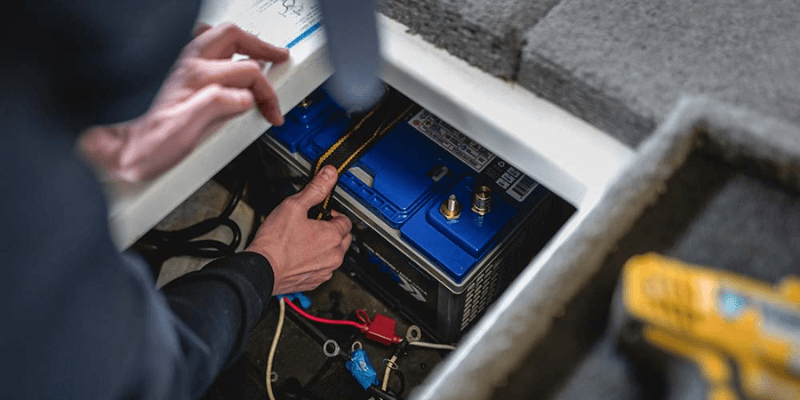
Hvilken størrelse marinebatteri har jeg brug for?
Marinebatterier kommer i forskellige størrelser for at imødekomme forskellige strømbehov og passer til specifikke bådrum, efter industristandard BCI Group Size-specifikationer. Større størrelser giver højere kapacitet til at drive flere elektronik, mens mindre størrelser passer til både med lavere strømkrav. At vælge den rigtige størrelse sikrer optimal ydeevne, effektiv pladsudnyttelse og pålidelig kraft under sejleventyr.
Lithium eller blysyre?
Lithium-batterier er overlegne i forhold til blysyre-batterier til marine applikationer af flere årsager. Deres høje energitæthed giver mulighed for mere strømlagring i en lettere pakke end bly-syre-batterier, hvilket forbedrer bådens ydeevne og brændstofeffektivitet. De har også en imponerende cykluslevetid, der varer tusindvis af opladningscyklusser, hvilket reducerer udskiftningsfrekvensen.
Derudover oplades lithiumbatterier hurtigere og mere effektivt, hvilket giver dig mere tid på vandet.
Selvom lithium-batterier har en højere pris på forhånd, giver deres holdbarhed og levetid langsigtet omkostningseffektivitet. I modsætning hertil er bly-syre-batterier budgetvenlige med lavere startomkostninger og en dokumenteret sikkerhedsrekord i marineindustrien. De er særligt velegnede til at starte applikationer på grund af deres manglende overstrømsbeskyttelse.
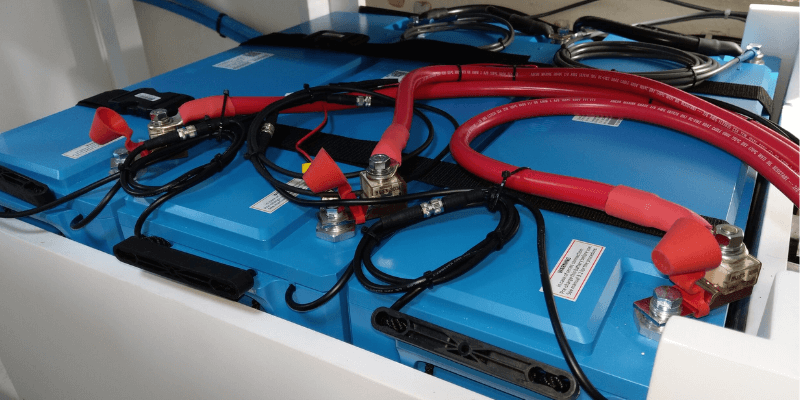
Kan jeg oplade et marinebatteri med en almindelig oplader?
Du kan oplade et marinebatteri med en almindelig oplader, hvis det matcher spændingen, men det anbefales ikke. Almindelige opladere opfylder muligvis ikke de specifikke behov for deep-cycle marine batterier, hvilket risikerer overopladning eller overdreven varme. Det er bedst at bruge en dedikeret marinebatterioplader designet til deep-cycle batterier med den passende opladningsprofil.
Til marine lithium batterier, en dedikeret lithium oplader vil fremskynde processen. Selvom det kan være en ekstra udgift, finder mange ejere det umagen værd for optimal batteriydelse.
Hvor længe holder marinebatterier?
Traditionelle marinebatterier holder typisk tre til seks år, svarende til bilbatterier, men levetiden varierer efter brug, vedligeholdelse og type. Startbatterier holder generelt tre til fem år. Deep cycle batterier er designet til tungere brug og holder omkring fire til seks år. Dual-purpose batterier spænder fra tre til seks år, afhængigt af deres brug i dit fartøj. Men hvis du bruger LiFePO4 marine batterier, kan de holde i over 10 år.

